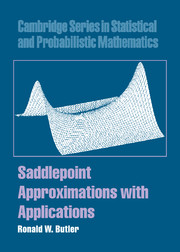Book contents
- Frontmatter
- Contents
- Preface
- 1 Fundamental approximations
- 2 Properties and derivations
- 3 Multivariate densities
- 4 Conditional densities and distribution functions
- 5 Exponential families and tilted distributions
- 6 Further exponential family examples and theory
- 7 Probability computation with p*
- 8 Probabilities with r*-type approximations
- 9 Nuisance parameters
- 10 Sequential saddlepoint applications
- 11 Applications to multivariate testing
- 12 Ratios and roots of estimating equations
- 13 First passage and time to event distributions
- 14 Bootstrapping in the transform domain
- 15 Bayesian applications
- 16 Nonnormal bases
- References
- Index
6 - Further exponential family examples and theory
Published online by Cambridge University Press: 25 February 2010
- Frontmatter
- Contents
- Preface
- 1 Fundamental approximations
- 2 Properties and derivations
- 3 Multivariate densities
- 4 Conditional densities and distribution functions
- 5 Exponential families and tilted distributions
- 6 Further exponential family examples and theory
- 7 Probability computation with p*
- 8 Probabilities with r*-type approximations
- 9 Nuisance parameters
- 10 Sequential saddlepoint applications
- 11 Applications to multivariate testing
- 12 Ratios and roots of estimating equations
- 13 First passage and time to event distributions
- 14 Bootstrapping in the transform domain
- 15 Bayesian applications
- 16 Nonnormal bases
- References
- Index
Summary
Statistical inference is considered in five practical settings. In each application, saddlepoint approximations offer an innovative approach for computing p-values, mid-p-values, power functions, and confidence intervals. As case studies, these five settings motivate additional considerations connected with both the saddlepoint methodology and theory that are used for making statistical inference. Each additional topic is addressed as it arises through its motivating example.
The first application concerns logistic regression, with an emphasis on the determination of LD50. p-value computation, test inversion to determine confidence intervals, and the notion of mid-p-values are considered. Saddlepoint treatment of prospective and retrospective analyses are also compared.
The second application deals with common odds ratio estimation. Both single- and double-saddlepoint methods are applicable and these two approaches are compared with several examples. Power function computations and their properties are discussed in connection with both the single- and double-saddlepoint approaches. Time series data may also be analyzed and an example dealing with an autoregression of Poisson counts is given.
The final two applications are concerned with modeling nonhomogeneous Poisson processes, and inference with data that has been truncated. The former example reconsiders the Lake Konstanz data analyzed in Barndorff-Nielsen and Cox (1979) and the latter deals with the truncation of binomial counts that occur with genetic data.
The general use of saddlepoint methods for testing purposes in exponential families was introduced in Davison (1988), however these applications had already been anticipated much earlier in the discussion by Daniels (1958) concerning the logistic setting as well as in Barndorff-Nielsen and Cox (1979). Test inversion to determine confidence intervals was first considered in Pierce and Peters (1992).
- Type
- Chapter
- Information
- Saddlepoint Approximations with Applications , pp. 183 - 218Publisher: Cambridge University PressPrint publication year: 2007

